A young, but gaining popularity among gardeners, cherry variety Revna
Revna cherries are known to gardeners due to their ease of care, resistance to fungal diseases and excellent frost resistance. Tasty fruits with juicy pulp are liked by adults and children. Let's look at how to grow this variety, what its features and advantages are.
Description of the variety
Revna belongs to the middle-late dessert category winter-hardy varieties of cherries. It takes 2.5 months from flowering to fruit ripening.
The berries ripen in late June - early July. The average yield per 1 ha is 73 centners, the maximum recorded is 112 centners/ha. During the season, up to 25 kg of fruits are obtained from the tree.
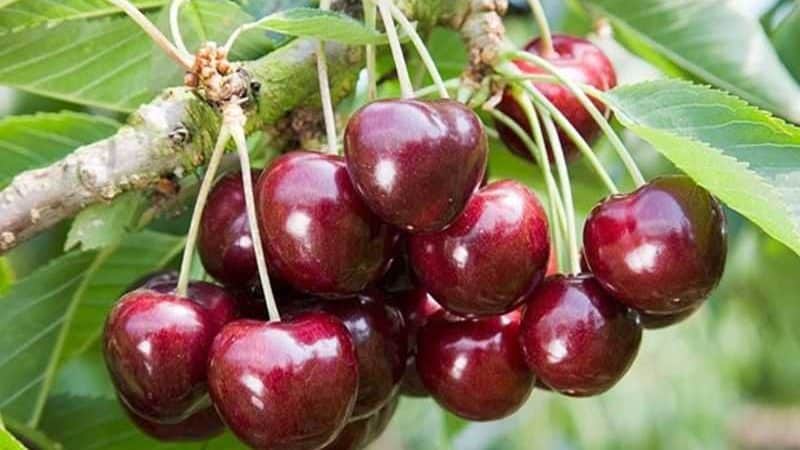
History of origin and distribution
Attempts by breeding scientists M.V. Kanshina and A.I. Astakhov to develop a frost-resistant cherry variety led to the appearance of Revna. The genetic material was the Bryansk pink variety.
Tests were carried out at the All-Russian Research Institute of Lupine in 1993. In 1994, Revna was included in the Unified State Register of the Russian Federation for the Central Region.
On a note! The name of the variety comes from the river of the same name, flowing near Bryansk.
Characteristics of trees
The tree grows to an average height, up to 3 m. The crown is pyramidal in shape and of medium density. The branches grow quickly at a large angle from the trunk.
Other characteristics:
- the leaves are dark green, large, broadly ovoid, with jagged edges;
- the buds on the branches are large, and during the period of vegetative growth they acquire an ovoid shape;
- inflorescence of 4 white flowers, saucer-shaped petals, arranged freely.
The first fruits appear 4 years after planting.
Temperature resistance
The main purpose of the variety is to withstand frosts down to -25...-30°C, which it copes with successfully. Recommended for planting in northern, central and southern regions.
In spring, during flowering, it can withstand temperatures dropping to -3...-5°C. Revna cherry is not afraid of heat up to +25°C, but at values higher than that, the leaves get sunburned.
Moisture and drought resistance
The variety is resistant to short-term drought, but during the period of fruit set and ripening it requires abundant watering once every 5–7 days.
Cherry does not like swampy, heavily waterlogged areas - in such conditions the growth of the tree is inhibited.
Resistance to diseases and pests
Revna cherries are immune to fungal diseases, including coccomycosis and moniliosis. Among the pests, the tree is affected by aphids, cherry flies, moths, and weevil larvae.
Description of berries
The berries are sweet, fleshy inside, round, medium in size, weigh 5–7 g. The color is dark burgundy; overripe fruits are black. Ripe berries do not crack and withstand transportation due to their durable skin.
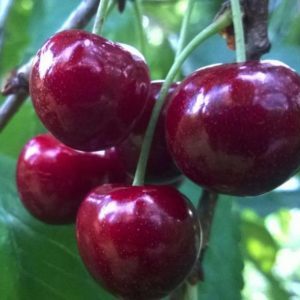
Areas of use
Cherries are eaten fresh, frozen, and made into compotes and jams. Wine is made from the berries at home, since the sugar content in the fruit reaches 13%.
Reference. Beekeepers locate apiaries near gardens with Revna, which is characterized by high honey productivity (up to 30 kg of honey per bee colony).
Advantages and disadvantages of the variety
The main advantages of culture: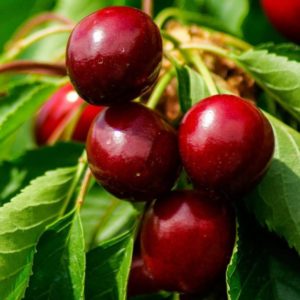
- fleshy sweet fruits;
- the bone is easily separated from the pulp;
- resistance to temperature changes and frost;
- the crop survives transportation;
- immunity to fungal diseases.
The main inconvenience in growing the variety is its inability to self-pollinate, so pollinating trees are planted nearby. Late fruiting in comparison with other varieties is also noted as a disadvantage.
Growing technology
It is better to plant plants in groups so that other trees do not cover them and allow them to cross-pollinate.
Landing dates and rules
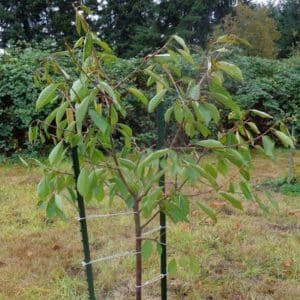
Landing carried out in early spring, when the soil has just thawed and the buds on the branches have not yet swelled.
During this period, the young tree is dormant and will tolerate replanting without pain.
When choosing a seedling, pay attention to the following characteristics:
- the root system is well developed;
- seedling height - up to 1 m;
- the roots are not dried out;
- barrel without mechanical damage.
If there is no grafting site, it will grow wild. For planting, both one-year and two-year-old seedlings are taken.
Optimal conditions:
- open plot of land with abundant sunlight;
- suitable soil - fertile chernozem with neutral acidity, loamy and sandy soil;
- groundwater should not approach the ground surface closer than 2 m;
- fences or buildings are no closer than 2.5 m.
The best solution for the neighborhood is to plant other varieties of cherries nearby. They do not conflict with each other and will pollinate well.
Other crops are grown nearby:
- trees and shrubs: cherry, black elderberry (the latter prevents the appearance of aphids);
- flowers: nasturtium, primrose, thyme.
Unsuitable neighbors - apple tree, plum tree, pear tree. They interfere with pollination. It is not advisable to plant nightshades (tomatoes, potatoes) nearby.
Compliance with the rules and technology of planting is a guarantee that the seedling will take root and bear fruit:
- The hole is dug in the fall.Depth - 0.5–0.8 m, distance between planting holes - at least 3 m. If the soil is acidic, the soil is limed.
- Closer to the center of the hole, a support stake up to 1.5 m high is driven in, which subsequently secures the seedling.
- A mound of fertilized soil is poured into the center, and a seedling is placed on top.
- The roots are carefully straightened, sprinkled with soil and lightly compacted. The root neck of the seedling should be flush with the ground surface.
- Water the plant generously (3-4 buckets of water) and wait until the liquid is completely absorbed.
- Fill the hole with a mixture of the remaining soil, humus and peat.
- Tie the trunk to the support.
The soil from the dug hole is not thrown away, but mixed with rotted compost, superphosphate is added (at the rate of 200 g per hole) and added when planting a tree.
Further care
In the absence of rain for a long time, the tree is moistened once every 10–14 days. If there is enough precipitation, the frequency of watering is reduced to 3-4 times per season. For convenience, an earthen bank is made around the trunk so that water gets directly to the roots.
On a note! The radius of the earthen rampart is equal to the radius of the crown circle.
In the third year after planting, humus or other fertilizers are added:
- in spring - mineral fertilizers (20 g of ammonium nitrate per 1 m²);
- in summer - potassium monophosphate.
In the fall, dig up the soil around the trunk.
Pruning and crown shaping are important for the tree. For the first 3–5 years, formative pruning is carried out:
- bush-like;
- flattened;
- tiered
Sanitary pruning is carried out as necessary: dry, diseased, weak or broken branches are removed.
Every spring the trunk of Revna is whitewashed. To do this, use a ready-made mixture purchased at a gardening store, or make it yourself from:
- slaked lime - 3 kg;
- copper sulfate - 0.5 kg;
- water - 10 l.
Possible problems, diseases, pests
Revna cherries are resistant to diseases, but with excessive watering, lack or excess of fertilizers, the following occur:
- Clusterosporiasis, or perforated spotting. Brown spots appear on the leaves, which rot and form holes. The affected parts of the plant are torn off and burned. For prevention, the tree is treated with Bordeaux mixture.
- Mosaic disease: leaves become covered with yellow stripes, curl, turn red and fall off. They are torn off and burned. Bordeaux mixture is used for prevention.
- Gommoz: Amber viscous drops appear on the trunk; people say that “the tree is crying.” As a result of the disease, the cherry tree dies. The wounds are cleaned, treated with a 3% solution of potassium permanganate and sprayed with Bordeaux mixture.
- Coccomycosis: Red-brown spots form on the leaves, which subsequently dry out and fall off. For treatment, use a solution of “Horus” (3 g per 10 l of water), “Topsin-M” (10 g per 10 l of water).
The main pests of cherries that feed on fruits and leaves are aphids, cherry flies, moths, weevil larvae, and moths. To combat them, chemical agents are used: Decis, Inta-Vir, Karbofos.
Birds also damage the crop. To protect the berries from them, shiny, rustling objects are hung on the branches: foil, thick polyethylene, old CDs, homemade turntables.
Read also:
Wintering
Despite good cold tolerance, cherries are prepared for wintering:
- treat the lower part of the trunk with garden whitewash, which is not washed off by rain or snow;
- wrap the trunk and lower branches with breathable covering material (spunbond, agril);
- to protect against field rodents, install a net around the trunk;
- They cover the tree with earth, leaves, and snow.
In warm regions, where the air temperature drops to -2...-5°C in winter, the trunk is not wrapped with covering material - condensation forms inside, which is detrimental to the tree.
In cold regions in late autumn, when the temperature drops to 0°C, a frame in the form of a pyramid of wooden slats or reinforcement is installed around the tree. The structure is wrapped in several layers of covering material and tied with rope. The lower edge is sprinkled with earth or pressed down with bricks. With the onset of a thaw, the shelter is removed.
Reproduction
Rhubarb is propagated by cuttings and grafting. Young trees (up to 10 years old) are used for grafting: cherries, plums, and other frost-resistant varieties of cherries.
How to get vaccinated:
- In mid-April, when the plant has active sap flow, take a cutting 30–40 cm long with two or more living buds.
- Cut the bark into the rootstock, apply a cut of the scion, and press well.
- Cover the joint with cut bark, coat it with garden varnish and wrap it with thick cloth or tape.
Cuttings are carried out in June. To do this, young cuttings 30 cm long are prepared. Cuts are made from the top and bottom of the shoot, and all leaves are removed. A solution of a growth stimulator (for example, Heteroauxin) is added to the water and the cuttings are placed in it for 2-3 hours.
At the planting site, they dig up the soil, remove weeds and make holes. A mixture of peat and sand is placed at the bottom, mineral fertilizers are added, watered and cuttings are planted. For them to take root, they create a mini-greenhouse made of plastic film. Water daily to keep the soil slightly moist.After 3–6 weeks, when the cuttings take root, the film is removed.
Features of cultivation depending on the region
When planting Revna, take into account the area of residence:
- In the middle zone, cherries bloom in mid-May. In the southern regions, the flowering period occurs in mid-April.
- Residents of warm southern regions plant plants in spring and autumn, in the north - only in spring, before the onset of sap flow and swelling of the buds.
- In the south there is no need to insulate the tree with covering material, as it tolerates frosts down to -5°C. In northern latitudes, they wrap the trunk, hill it up, and build a shelter.
Pollinator varieties
Revna is not able to self-pollinate. Other varieties of cherries are planted for pollination: Ovstuzhenka, Iput, Rechitsa, Tyutchevka, Compact Venyaminova. Cherry trees are also suitable.
Important! Without pollinators, cherry yield is only 5%.
Reviews from gardeners
Farmers share their experience of growing Revna.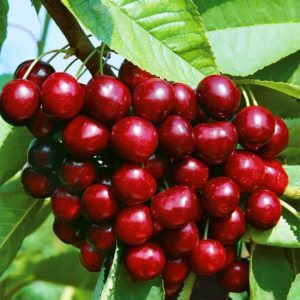
Anna, Belgorod region: “My sister grows Revna cherries in her summer cottage. It was frosty down to -30°C - they thought he wouldn’t survive, but nothing happened. We already tried the berries in the summer, they are very tasty!”
Oleg, Saratov: “I planted Revna cherries about five years ago on the advice of a neighbor. I thought it wouldn’t take root, but 5 seedlings are already bearing fruit. We enjoy delicious berries, my wife makes compote for the winter.”
Conclusion
Many gardeners fell in love with the Revna variety for its advantages: tasty and juicy fruits, universal in use, high yield, resistance to cold and disease. The unpretentiousness of the culture allows you to spend a minimum of time caring for it.